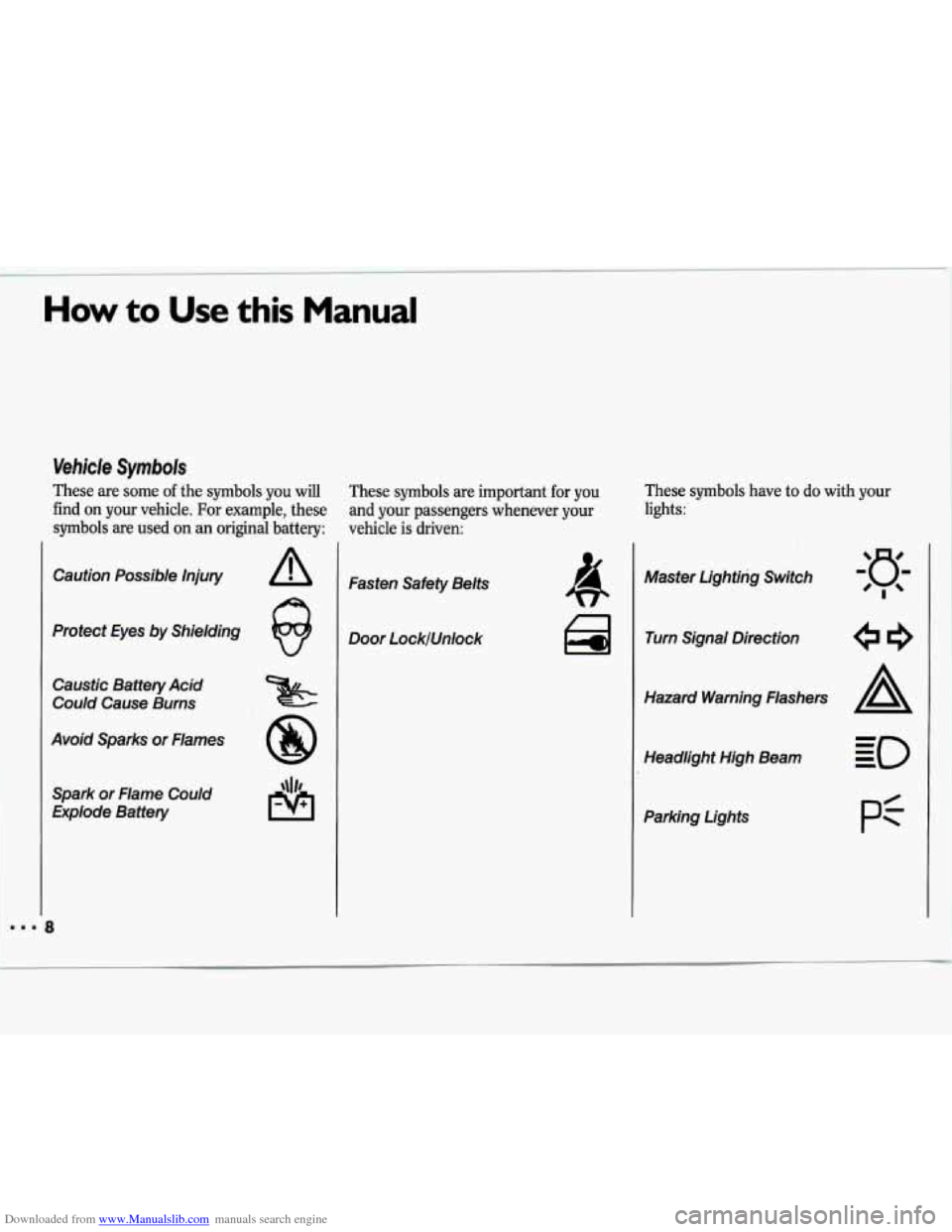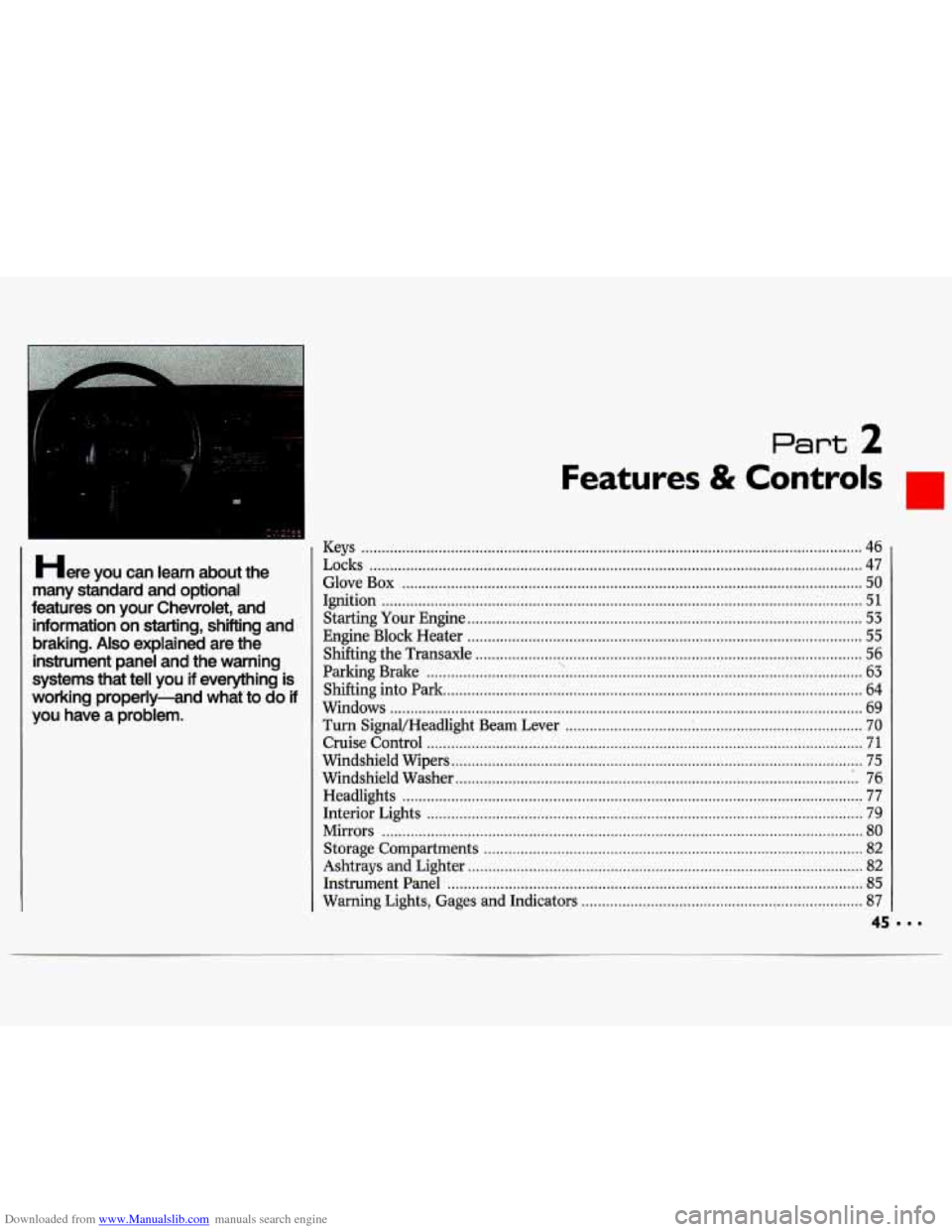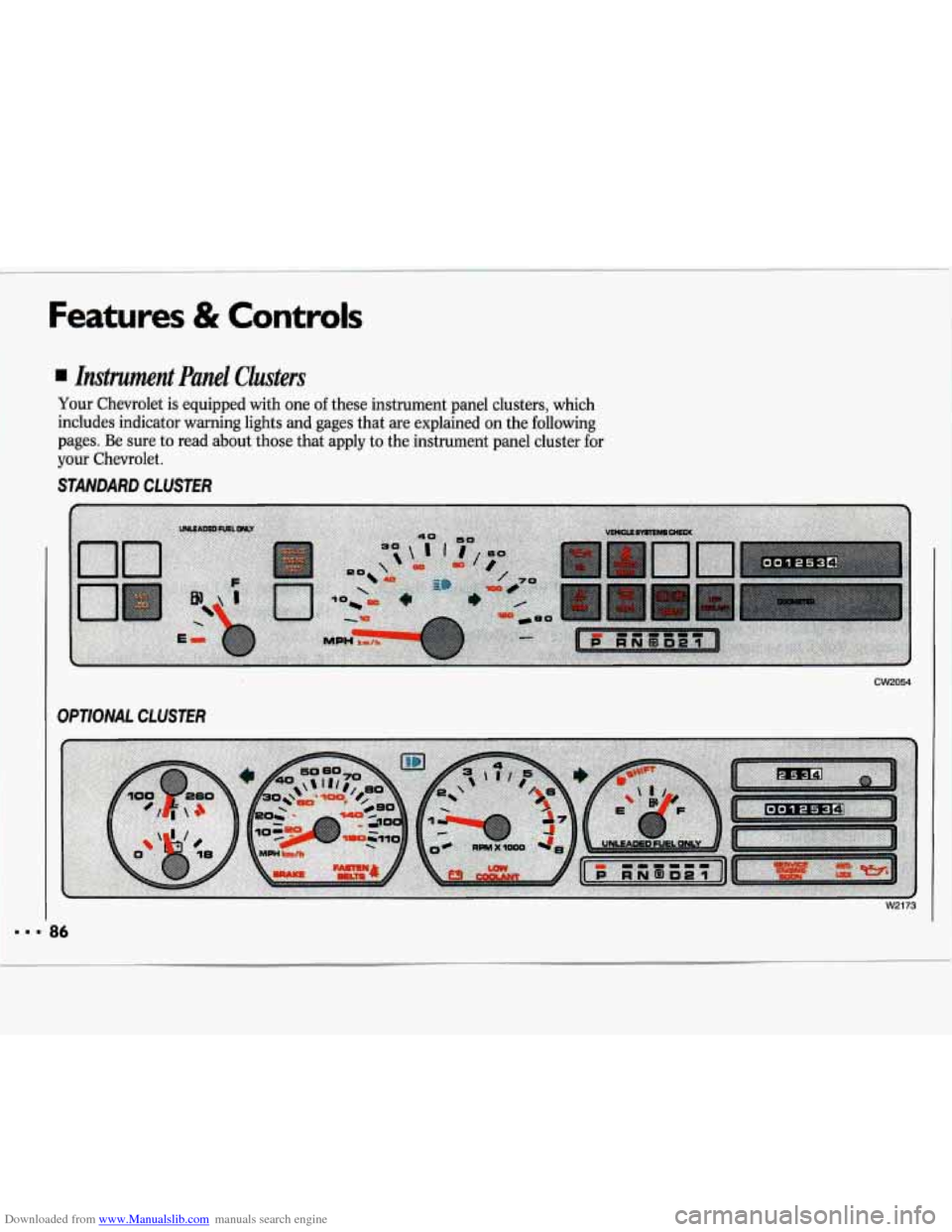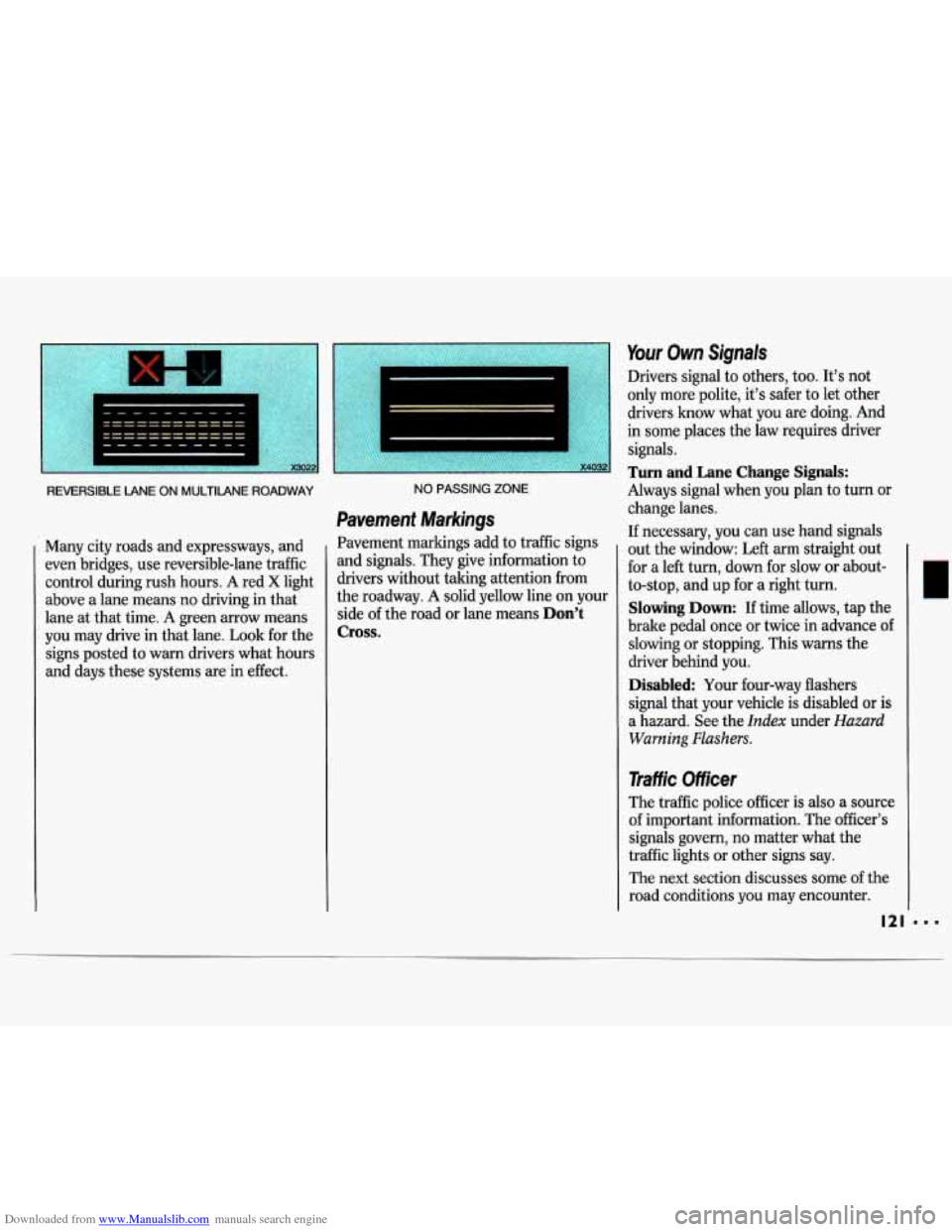1993 CHEVROLET LUMINA warning lights
[x] Cancel search: warning lightsPage 10 of 324

Downloaded from www.Manualslib.com manuals search engine How to Use this Manual
Vehicle Symbols
These are some of the symbols you will
find on your vehicle. For example, these
symbols
are used on an original battery: These symbols
are important for you
and your passengers whenever your
vehicle is driven: These
symbols have
to do with your
lights:
Caution Possible Injury
Protect
Eyes by Shielding
Caustic Battery Acid
Could Cause Burns
Avoid Sparks or Flames
Spark or Flame Could
Explode Battery Fasten Safety Belts
Door Lock/Unlock
la Turn Signal Direction
Hazard Warning Flashers
Headlight High Beam
Parking Lights
pf
Page 11 of 324

Downloaded from www.Manualslib.com manuals search engine These symbols are on some of your
controls:
Windshield Wipers
Windshield Washer
Windshield Defroster
Rear Window Defogger Ventilating Fan
Power Window
These symbols are used on warning and
indicator lights:
Engine Coolant
Temperature
'*Yi Battery Charging
Q I System
Engine Oil Pressure
3f
Brake
Anti-Lock Brakes
Here are some other symbols you may
see:
Fuse
Trunk Release
Lighter
Horn Speaker
Hood Release
Page 47 of 324

Downloaded from www.Manualslib.com manuals search engine Here you can learn about the
many standard and optional
features on your Chevrolet. and information
on starting. shifting and
braking
. Also explained are the
instrument panel and the warning
systems that tell you if everything is
working properly+ nd what to
do if
you have a problem .
Part 2
Features & Controls .
Keys ........................................................................\
................................................... 46
Locks
........................................................................\
................................................. 47
Glove Box
........................................................................\
......................................... 50
Ignition
........................................................................\
.............................................. 51
Starting Your Engine
........................................................................\
......................... 53
Engine Block Heater
........................................................................\
......................... 55
Shifting the Transaxle
........................................................................\
....................... 56
Parking Brake ........................................................................\
................................... 63
Shifting into Park
........................................................................\
............................... 64
Windows
........................................................................\
............................................ 69
Turn SignaVHeadlight Beam Lever ............................... : ......................................... 70
Cruise Control ........................................................................\
................................... 71
Windshield Wipers ........................................................................\
............................. 75
Windshield Washer
........................................................................\
........................... 76
Headlights
........................................................................\
......................................... 77
Interior Lights ........................................................................\
................................... 79
Mirrors ........................................................................\
.............................................. 80
Storage Compartments
........................................................................\
..................... 82
Ashtrays and Lighter
........................................................................\
......................... 82
Instrument Panel
........................................................................\
.............................. 85
Warning Lights, Gages and Indicators
..................................................................... 87
...
Page 53 of 324

Downloaded from www.Manualslib.com manuals search engine New Vehicle “Break-ln”
/gnition Switch
With the ignition key in the ignition
switch, you can turn the switch to five
positions:
Accessory: An “on” position in which
you can operate your radio and
windshield wipers. Press in the ignition
switch as you turn the top
of it toward
you.
Lock The only position in which you
can remove the key. This locks your
steering wheel, ignition and transaxle.
I
Off: Unlocks the steering wheel,
ignition, and transaxle, but does not
send electrical power to any accessories.
Use this position if your vehicle must be
pushed or towed, but never try to push-
start your vehicle. A warning chime will
sound
if you open the driver’s door
when the ignition is
off and the key is in
the ignition.
Run: An “on” position to which the
switch returns after you start your
engine and release the switch. The
switch stays in the
Run position when
the engine is running. But even when
the engine is not running, you can use
Run to operate your electrical power
accessories, and to display some instru-
ment panel warning lights.
Page 79 of 324

Downloaded from www.Manualslib.com manuals search engine Headlights
The main light controls are on the left
side of the instrument panel. Push the
switch marked
pf to turn on your:
Parking Lights
Side Marker Lights
Taillights
License Plate Lights
Instrument Panel Lights
Push the switch again to turn them off. Push
the switch marked
-g- to turn on
your headlights, together with your:
Parking Lights
Side Marker Lights
Taillights
License Plate Lights
Instrument Panel Lights
Push the switch again to turn them off.
Operation of Lights
Although your vehicle’s lighting system
(headlamps, parking lamps, fog lamps,
side marker lamps and tail lamps) meets
all applicable federal lighting
requirements, certain states and
provinces may apply their
own lighting
regulations that may require special
attention before
you operate these
lamps. For example, some jurisdictions
may require that you operate your lower
beam lamps with fog lamps
at all times,
or that headlamps be turned on
whenever you must use your windshield
wipers. In addition, most jurisdictions
prohibit drively solely with parking
lamps, especially at dawn or
dusk. It is
recommended that you check with your
own state or provincial highway
authority for applicable lighting
regulations.
Lights On Reminder
If you open the door with the ignition
off and the lights on, you will hear
a
warning chime.
Page 88 of 324

Downloaded from www.Manualslib.com manuals search engine Features & Controls
Instrument Panel Clusters
Your Chevrolet is equipped with one of these instrument panel clusters, which
includes indicator warning lights and gages that are explained
on the following
pages. Be sure to read about those that apply to the instrument panel cluster for
your Chevrolet
.
STANDARD CLUSTER
cw2054
OPTIONAL CLUSTER
W2173
Page 89 of 324

Downloaded from www.Manualslib.com manuals search engine Warning Lights, Gages and
Indicators
This section describes the warning lights
and gages that may be on your vehicle.
The pictures will help you locate them.
Warning lights and gages can signal that
something is wrong before it becomes
serious enough to cause an expensive
repair or replacement. Paying attention
to your warning lights and gages could
also save you or others
from injury.
Warning lights go on when there may
be or is a problem with one of your
vehicle’s functions.
As you will see in the
details on the next few pages, some
warning lights come on briefly when
you turn the ignition key just to let you
lmow they’re working. If you are
familiar with this section, you should
not be alarmed when this happens.
Gages can indicate when there may be
or is a problem with one
of your
vehicle’s functions. Often gages and
warning lights work together to let you
know when there’s a problem with your
vehicle. When
one of the warning lights comes
on and stays on when you are driving,
or when one of the gages shows there
may be a problem, check the section
that tells you what to do about it. Please
follow the manual’s advice. Waiting to
do repairs can be costly-and even
dangerous, So please get to how your
warning lights and gages. They’re a big
help.
87
Page 123 of 324

Downloaded from www.Manualslib.com manuals search engine REVERSIBLE LANE ON MULTILANE ROADWAY
Many city roads and expressways, and
even bridges, use reversible-lane traffic control during rush hours.
A red X light
above
a lane means no driving in that
lane at that time.
A green arrow means
you may drive in that lane.
Look for the
signs posted to warn drivers what hours
and days these systems are in effect.
NO PASSING ZONE
Pavement Markings
Pavement markings add to traffic signs
and signals. They give information to
drivers without taking attention from
the roadway.
A solid yellow line on your
side of the road or lane means
Don’t
Cross.
Your Own Signals
Drivers signal to others, too. It’s not
only more polite, it’s safer to let other
drivers know what you are doing. And
in some places the law requires driver
signals.
Turn and Lane Change Signals:
Always signal when you plan to turn or
change lanes.
If necessary, you can use hand signals
out the window: Left arm straight out
for a left turn, down for slow or about-
to-stop, and up for a right turn.
Slowing Down: If time allows, tap the
brake pedal once or twice in advance of
slowing or stopping. This warns the
driver behind you.
Disabled Your four-way flashers
signal that your vehicle is disabled or
is
a hazard. See the Index under Hazard
Warning Flashers.
Traffic Officer
The traffic police officer is also a source
of important information. The officer’s
signals govern, no matter what the
traffic lights or other signs say.
The next section discusses some of the
road conditions you may encounter.